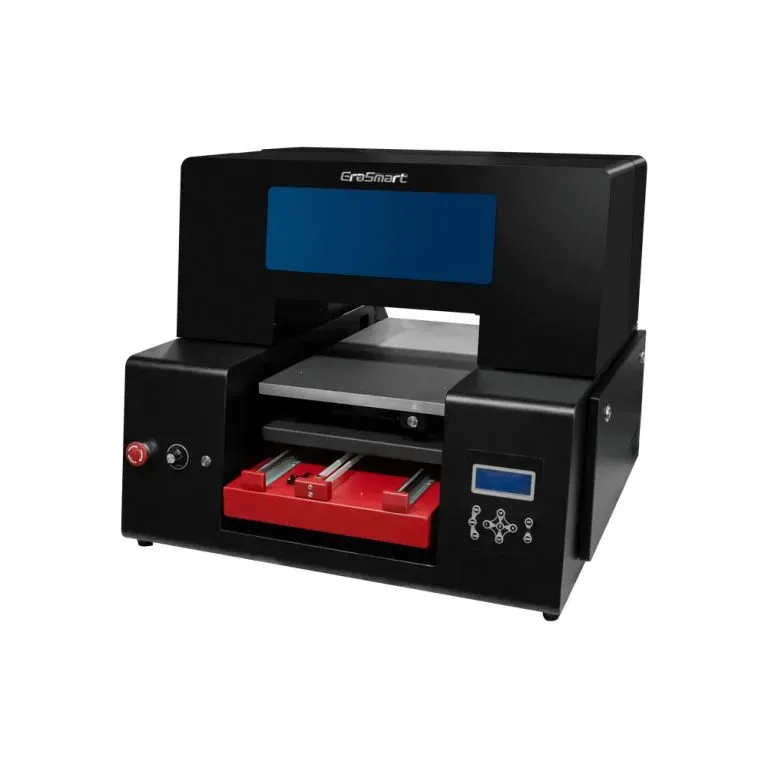UV DTF technology, or Ultraviolet Direct-to-Film printing, is revolutionizing the custom printing landscape by marrying the efficiency of Direct-to-Film techniques with the innovative advantages of UV curing. This cutting-edge printing method allows for vibrant colors and intricate designs on a variety of materials, such as textiles, ceramics, and plastics, pushing the boundaries of UV printing capabilities. With the rise of sustainable inks being used in UV DTF processes, businesses can now create eye-catching prints that are not only durable but also eco-friendly. As printing innovations continue to evolve, UV DTF technology stands out for its versatility and exceptional output quality, making it a preferred choice for custom printing needs. This technology is paving the way for more personalized products in various industries, ensuring that businesses remain competitive in an ever-changing market.
Known as ultraviolet direct-to-film printing, UV DTF technology represents a significant leap in custom printing technology. This state-of-the-art approach combines traditional Direct-to-Film printing methods with the rapid curing capabilities of UV light, allowing for quick and efficient production of high-quality prints. Utilizing environmentally friendly inks, this technology not only enhances the sustainability of printing practices but also ensures vibrant and long-lasting designs across multiple substrates. The versatility of UV DTF extends beyond textiles, enabling the printing of intricate graphics on materials like ceramics and glass. As the demand for personalized and durable products grows, this innovative printing solution is becoming increasingly sought-after in various sectors.
The Evolution of UV DTF Technology
The evolution of UV DTF technology symbolizes a significant leap in the world of printing, merging the precision of UV printing with the adaptability of Direct-to-Film methods. This hybrid innovation creates a new paradigm where businesses can produce high-quality prints on an enormous variety of substrates—everything from textiles to metals. By utilizing UV-curable inks, which harden instantly under UV light, UV DTF not only speeds up the printing process but also enhances the overall quality of the prints, resulting in vibrant colors and intricate details that were previously unattainable.
This advancement has paved the way for creative industries to explore new possibilities in custom printing technology. For instance, artists and designers can experiment with unique materials, pushing the boundaries of traditional printing. The flexibility offered by UV DTF technology provides businesses the opportunity to streamline their workflows while maintaining high standards of quality, making it a game-changer in fields such as promotional merchandise and bespoke product creation.
Key Benefits of UV DTF Printing
UV DTF printing boasts several key benefits that make it an attractive option for businesses looking to enhance their product offerings. One of the standout advantages is its versatility; it can seamlessly print on a vast array of materials beyond textiles, including ceramics, glass, and plastics. This capability allows companies to cater to diverse markets, expanding their reach and attracting a broader customer base. With UV DTF, the challenges of printing on different surfaces are mitigated, providing a universal solution for custom projects.
Moreover, the durability of UV-cured inks sets UV DTF apart from traditional printing methods. The inks are resilient against outdoor elements, which is crucial for products like signage or promotional items destined for prolonged exposure to sunlight. Such durability ensures that customers receive high-quality products that last, which inevitably translates to greater customer satisfaction and loyalty.
Eco-Friendly Innovations in UV DTF
Recent advancements in UV DTF technology focus heavily on sustainability, especially with the introduction of eco-friendly ink formulations. Brands like Mimaki are leading the charge by developing inks that not only adhere to stringent environmental standards but also exhibit exceptional performance. These sustainable inks ensure that prints are vibrant and flexible while being less harmful to the environment, making them an ideal choice for conscience-driven consumers and businesses.
The push for sustainability doesn’t just end with the inks; it extends to the entire production process as well. The efficiency brought by automated systems and next-generation printers minimizes waste and energy consumption. Thus, utilizing UV DTF technology enables businesses to reduce their carbon footprint while still delivering high-quality products, merging profit with environmental responsibility.
Exploring the Applications of UV DTF
The applications of UV DTF technology are expansive and span various industries. Within the realm of custom drinkware, products such as tumblers and bottles benefit immensely from the print quality and durability offered by UV DTF. These items not only need to endure regular washing but also demand striking designs that capture consumer attention. The ability to create vibrant and lasting visuals ensures that companies can effectively market their products.
Furthermore, the technology’s versatility extends to signage and interior décor, where intricate designs can enhance both commercial and residential spaces. Businesses can apply UV DTF for unique promotional items that resonate with their brand identity, such as custom keychains or artwork, showcasing the technology’s transformative potential in enhancing product appeal and marketability.
Future Trends in UV DTF Technology
Looking ahead, the future of UV DTF technology appears promising and dynamically responsive to market demands. With ongoing research and development in printing innovations, manufacturers are expected to continue introducing advanced printers and inks capable of delivering even more impressive results. Emerging features in these technologies may include automated color matching and smart printing settings that adapt to material types, ultimately increasing efficiency and reducing production times.
Additionally, as consumer preferences lean more towards sustainability, it’s likely that UV DTF will incorporate even more eco-friendly practices, from ink formulations to waste management. Companies that leverage these advancements will not only remain competitive but will also position themselves as environmentally conscious players in the market, appealing to a growing demographic of consumers who prioritize sustainable manufacturing.
The Competitive Edge of UV DTF Technology
As businesses navigate the complexities of the modern marketplace, the competitive edge provided by UV DTF technology becomes increasingly apparent. Companies that invest in this innovative printing technology can offer unique, high-quality products that align with consumer expectations for customization and durability. The efficiency and versatility of UV DTF allows businesses to respond swiftly to customer demands, creating a robust service offering that enhances brand loyalty.
In today’s saturated market, standing out requires more than just good products; it necessitates innovation and adaptability. With UV DTF technology, businesses can capitalize on this potential, ensuring they remain at the forefront of printing innovations while meeting diverse client needs. As organizations continue to explore the capabilities of UV DTF, they will unlock new possibilities in product offerings and creative solutions.
Frequently Asked Questions
What is UV DTF technology and how does it work?
UV DTF (Ultraviolet Direct-to-Film) technology is a modern printing method that combines traditional direct-to-film techniques with UV curing processes. It involves printing designs onto a special film using UV-curable inks, which are quickly solidified under UV light, enhancing print vibrancy and durability. This technology supports high-quality custom printing on various substrates including textiles, glass, and metal.
What are the advantages of using UV DTF technology in custom printing?
UV DTF technology offers numerous advantages for custom printing, including versatility in printing on a wide range of materials, exceptional durability of prints, and an enhanced color spectrum that replicates about 80% of visible colors. This makes it ideal for applications like custom drinkware and outdoor signage, where vivid and long-lasting prints are essential.
How do eco-friendly inks contribute to the effectiveness of UV DTF technology?
The use of next-generation eco-friendly inks in UV DTF technology, such as Mimaki’s ELS-170 and ELH-100, enhances the printing process by producing vibrant colors while meeting strict environmental standards. These sustainable inks are highly flexible, allowing for quality prints on both rigid and flexible surfaces, making them a perfect fit for diverse custom printing applications.
In what industries is UV DTF technology commonly used?
UV DTF technology is gaining traction across various industries including promotional products, signage, interior décor, and custom drinkware. Its capability to produce stunning, durable prints makes it suitable for creating promotional items and decorative materials that require a high level of customization and visual appeal.
What innovations are currently shaping the future of UV DTF technology?
Recent innovations in UV DTF technology include the development of advanced printers, such as Mimaki’s UJV300DTF-75, which enhance print stability. Additionally, automated cutting technologies increase production efficiency, while eco-friendly ink advancements further enhance the sustainability of custom printing applications, positioning UV DTF as a leader in printing innovations.
How does UV DTF technology compare to traditional printing methods?
UV DTF technology surpasses traditional printing methods by offering improved color vibrancy, durability, and versatility across multiple materials. Unlike conventional techniques, UV DTF utilizes UV-curable inks that cure rapidly, ensuring high-quality outputs in less time and allowing for intricate designs that would be challenging with typical printing processes.
| Key Point | Description |
|---|---|
| Introduction | UV DTF technology integrates efficient printing with UV curing, allowing high-quality prints on various materials. |
| Technology Process | Involves printing on a special film with UV inks, curing the inks with UV light, enhancing production and durability. |
| Key Developments | Includes advanced printers, eco-friendly inks, and automated cutting technologies improving efficiency. |
| Benefits | Versatile for multiple materials, durable for outdoor use, and achieves an enhanced color range. |
| Practical Applications | Used for custom drinkware, signage, and promotional items, enhancing visual appeal. |
Summary
UV DTF technology is revolutionizing the printing industry by offering an innovative solution that marries traditional printing methods with advanced UV curing processes. This state-of-the-art approach allows businesses to produce high-quality, customizable products on a wide range of substrates, ensuring vibrant colors and impressive durability. As UV DTF technology continues to evolve, it positions itself as an essential tool for industries looking to maximize creativity and efficiency while adhering to sustainability standards. The ongoing advancements in equipment and inks promise a bright future for companies that adopt UV DTF technology, making it a critical component in the quest for high-impact promotional and decorative items.



